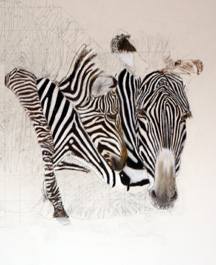 This animal portrait painting of Zebras is very technical as far as the placement of the stripes. Since every Zebra has their own stripe pattern and each stripe identifies that particular animal, this painting of a mother and her offspring is just as intricate as my portraits of people.
This animal portrait painting of Zebras is very technical as far as the placement of the stripes. Since every Zebra has their own stripe pattern and each stripe identifies that particular animal, this painting of a mother and her offspring is just as intricate as my portraits of people.
Using pastels to create the stripes is a time-consuming and intense process. Many layers of pastel have to be applied to finally get the crisp lines of the stripes. Even the colors have to be built up from medium to dark so that the end color has the layers of color that will give a rich natural look when the painting of the Zebras is finished.
Right now I am very happy to have gotten the mother and her babies face in place. The face and the legs of these animals are the most complicated areas of the body because of the intricate striped pattern, so to paint this original portrait, moving slowly is key. While painting this piece, I cannot jump around and paint different areas. I have to concentrate and do each area next to the most recently completed one, as some stripes connect to others in their overlapping bodies.
As a rule, after one year the dark brown zebra stripes generally turn to the familiar black; however, this mother still has some dark brown on her face and neck, while the rest of her body stripes have already turned to more dark black tones. Her foal, of course, is mostly dark brown with some areas of black.
As an animal portrait artist, waiting is the game you play when your working with painting animals. It takes hours until a “Tender Moment” happens. This one happened on a hot summers day when the Mother decided to lie down. The baby had a lower perseptive and they could look into eachother’s eyes as her baby walked over for some mothers milk or maybe for a little loving.
Written by: L.A. Cline, Master Pastel Artist